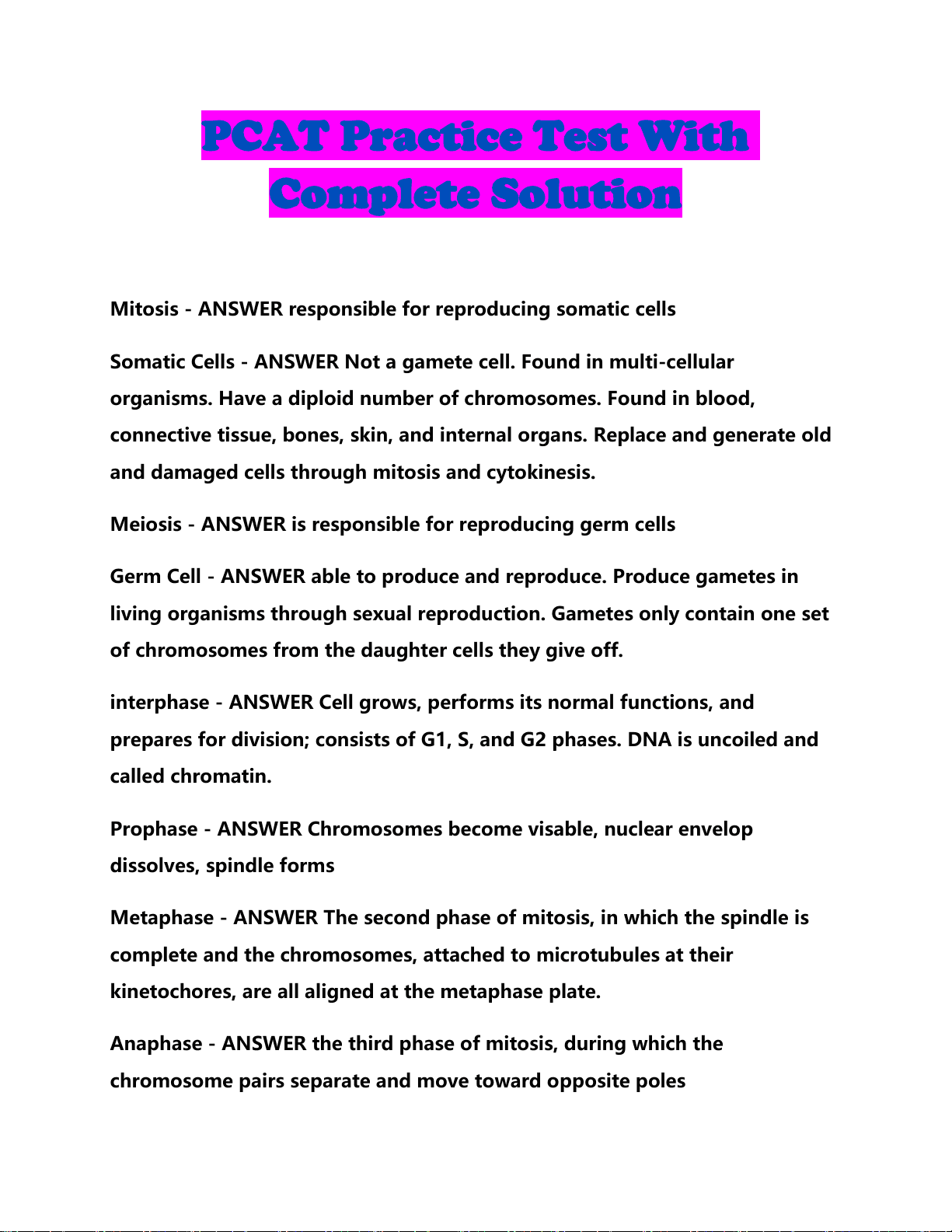
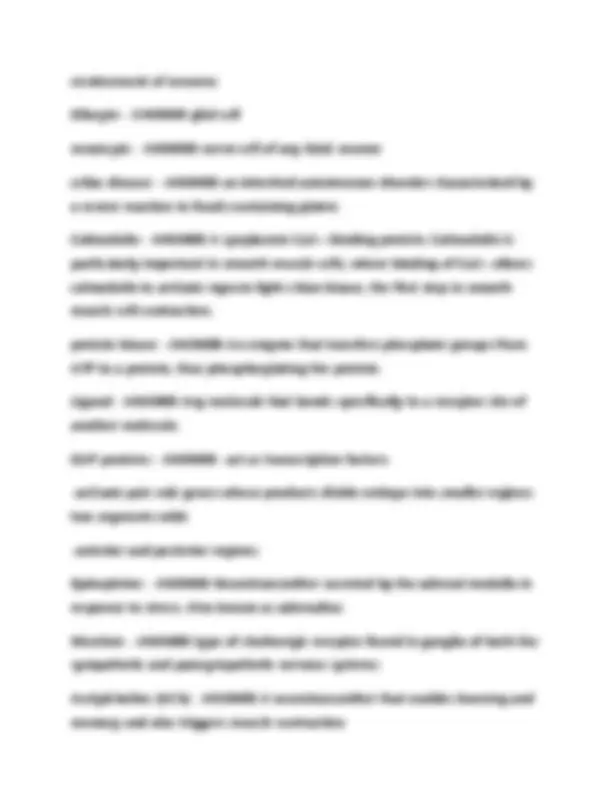
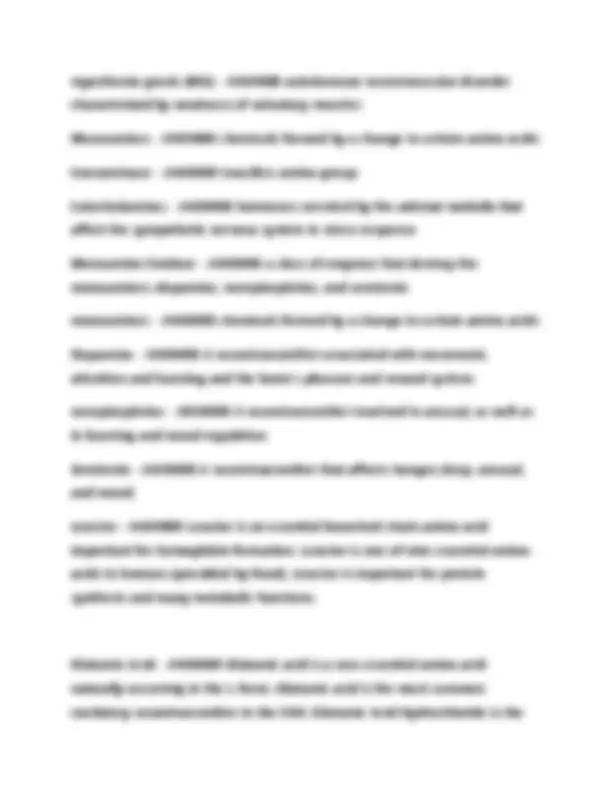
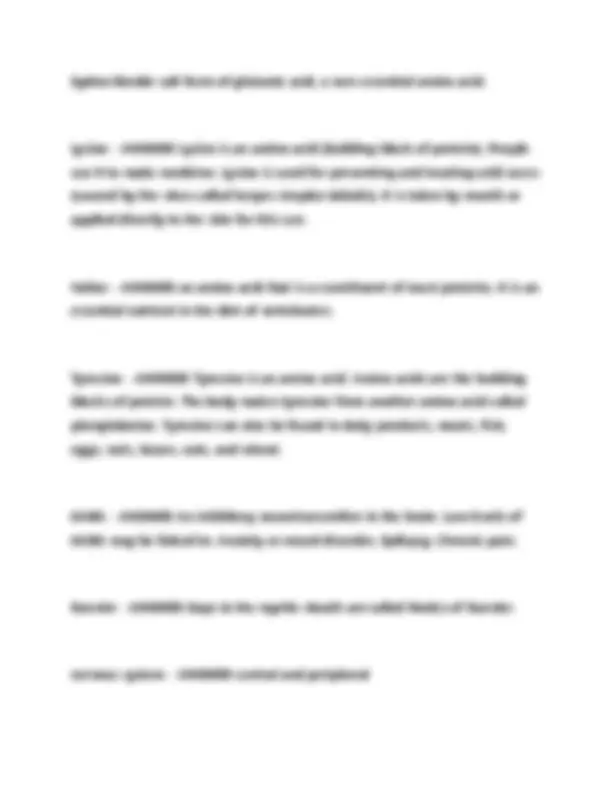
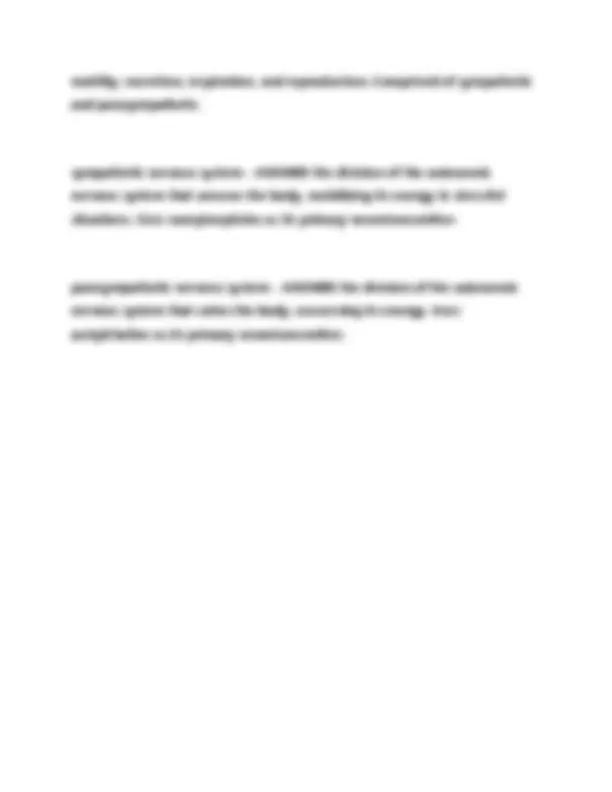


Study with the several resources on Docsity

Earn points by helping other students or get them with a premium plan


Prepare for your exams
Study with the several resources on Docsity

Earn points to download
Earn points by helping other students or get them with a premium plan
Community
Ask the community for help and clear up your study doubts
Discover the best universities in your country according to Docsity users
Free resources
Download our free guides on studying techniques, anxiety management strategies, and thesis advice from Docsity tutors
A comprehensive set of questions and answers covering key concepts in cell biology (mitosis, meiosis, cell cycle phases), the nervous system (structure, neurotransmitters, glial cells), and biochemistry (amino acids, proteins). It's valuable for students preparing for the pcat or similar exams, reinforcing understanding through practice and self-assessment. The q&a format facilitates learning and knowledge retention.
Typology: Exams
1 / 8

This page cannot be seen from the preview
Don't miss anything!





Mitosis - ANSWER responsible for reproducing somatic cells
Somatic Cells - ANSWER Not a gamete cell. Found in multi-cellular organisms. Have a diploid number of chromosomes. Found in blood, connective tissue, bones, skin, and internal organs. Replace and generate old and damaged cells through mitosis and cytokinesis.
Meiosis - ANSWER is responsible for reproducing germ cells
Germ Cell - ANSWER able to produce and reproduce. Produce gametes in living organisms through sexual reproduction. Gametes only contain one set of chromosomes from the daughter cells they give off.
interphase - ANSWER Cell grows, performs its normal functions, and prepares for division; consists of G1, S, and G2 phases. DNA is uncoiled and called chromatin.
Prophase - ANSWER Chromosomes become visable, nuclear envelop dissolves, spindle forms
Metaphase - ANSWER The second phase of mitosis, in which the spindle is complete and the chromosomes, attached to microtubules at their kinetochores, are all aligned at the metaphase plate.
Anaphase - ANSWER the third phase of mitosis, during which the chromosome pairs separate and move toward opposite poles
Telophase - ANSWER "Final phase of mitosis during which chromosomes uncoil, a nuclear envelope returns around the chromatin, and a nucleolus becomes visible in each daughter cell"
Cytokinesis - ANSWER The final stage of the cell cycle, in which the cell's cytoplasm divides, distributing the organelles into each of the two new cells. In animal cells, a cleavage furrow forms.
Prophase I - ANSWER The first phase of meiosis I. During prophase I the replicated chromosomes condense, homologous chromsomes pair up, crossing over occurs between homologous chromosomes, the spindle is formed, and the nuclear envelope breaks apart into vesicles. Prophase I is the longest phase of meiosis.
Metaphase I - ANSWER The pairs of homologous chromosomes line up in the center of the cell. The centromere of each chromatid pair attaches to one spindle fibre.
Anaphase I - ANSWER The third phase of meiosis I. the replicated homologous chromosomes are separated (the tetrad is split) and pulled to opposite sides of the cell.
Telophase I - ANSWER The cytoplasm divides and two new cells form. Each new cell has one duplicated chromosome from each similar pair.
Schwann cells (PNS) - ANSWER Type of glia in the PNS, Supporting cells of the peripheral nervous system responsible for the formation of myelin sheeth
Oligodendrocytes (CNS) - ANSWER form the myelin sheath in the brain and the spinal cord
Astrocytes (CNS) - ANSWER for blood brain barrier; control external
myasthenia gravis (MG) - ANSWER autoimmune neuromuscular disorder characterized by weakness of voluntary muscles
Monoamines - ANSWER chemicals formed by a change in certain amino acids
transaminase - ANSWER transfers amino group
Catecholamines - ANSWER hormones secreted by the adrenal medulla that affect the sympathetic nervous system in stress response
Monoamine Oxidase - ANSWER a class of enzymes that destroy the monoamines: dopamine, norepinephrine, and serotonin
monoamines - ANSWER chemicals formed by a change in certain amino acids
Dopamine - ANSWER A neurotransmitter associated with movement, attention and learning and the brain's pleasure and reward system.
norepinephrine - ANSWER A neurotransmitter involved in arousal, as well as in learning and mood regulation
Serotonin - ANSWER A neurotransmitter that affects hunger,sleep, arousal, and mood.
Leucine - ANSWER Leucine is an essential branched-chain amino acid important for hemoglobin formation. Leucine is one of nine essential amino acids in humans (provided by food), Leucine is important for protein synthesis and many metabolic functions.
Glutamic Acid - ANSWER Glutamic acid is a non-essential amino acid naturally occurring in the L-form. Glutamic acid is the most common excitatory neurotransmitter in the CNS. Glutamic Acid Hydrochloride is the
hydrochloride salt form of glutamic acid, a non-essential amino acid.
Lysine - ANSWER Lysine is an amino acid (building block of protein). People use it to make medicine. Lysine is used for preventing and treating cold sores (caused by the virus called herpes simplex labialis). It is taken by mouth or applied directly to the skin for this use.
Valine - ANSWER an amino acid that is a constituent of most proteins. It is an essential nutrient in the diet of vertebrates.
Tyrosine - ANSWER Tyrosine is an amino acid. Amino acids are the building blocks of protein. The body makes tyrosine from another amino acid called phenylalanine. Tyrosine can also be found in dairy products, meats, fish, eggs, nuts, beans, oats, and wheat.
GABA - ANSWER An inhibitory neurotransmitter in the brain. Low levels of GABA may be linked to: Anxiety or mood disorder, Epilepsy, Chronic pain.
Ranvier - ANSWER Gaps in the myelin sheath are called Nodes of Ranvier.
nervous system - ANSWER central and peripheral
Cerebellum - ANSWER the "little brain" at the rear of the brainstem; functions include processing sensory input and coordinating movement output and balance
Pons - ANSWER A brain structure that relays information from the cerebellum to the rest of the brain
Medulla - ANSWER an extension of the spinal cord into the skull that coordinates heart rate, circulation, and respiration
spinal cord - ANSWER a major part of the central nervous system which conducts sensory and motor nerve impulses to and from the brain
peripheral nervous system - ANSWER somatic and autonomic
somatic nervous system - ANSWER Division of the PNS that controls the body's skeletal muscles.
autonomic nervous system - ANSWER The part of the PNS that controls the glands and the muscles of the internal organs. Also Called involuntary nervous system. Important in blood pressure control, gastrointestinal
motility, excretion, respiration, and reproduction. Comprised of sympathetic and parasympathetic.
sympathetic nervous system - ANSWER the division of the autonomic nervous system that arouses the body, mobilizing its energy in stressful situations. Uses norepinephrine as its primary neurotransmitter.
parasympathetic nervous system - ANSWER the division of the autonomic nervous system that calms the body, conserving its energy. Uses acetylcholine as its primary neurotransmitter.